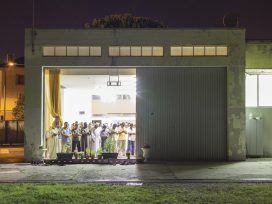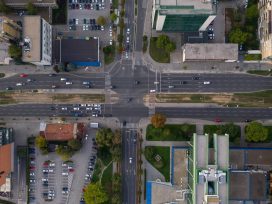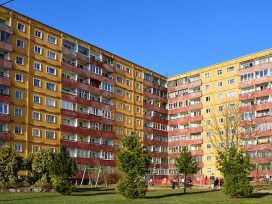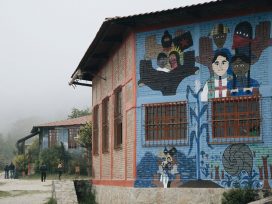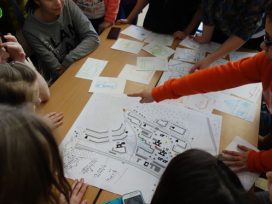
Toni Negri: As we have seen in the urban struggles that have recently taken place – I am thinking about the reaction to the closure of the Ungdomshuset social centre in Copenhagen last August, or this incredible thing that happened in Rostock on the margins of the G8 summit last June – the watchword of the European autonomous movements today is “take back the metropolis, take back the city, take back the centre”. This has become a widespread rallying cry: these movements, which have begun in the cities, are, from a political point of view, extremely important. Then in February 2007 there was the huge mobilization in Vicenza – this old catholic stronghold – against the expansion of the Nato airbase there. Nato is transferring all its resources for potential military intervention – particularly aimed at the Middle East – to Vicenza and Udine. And this is what people – not only those from the movement, but the city residents in general – refuse. The struggle has thus spread across the board: no-global movements, neighbourhood groups, Catholics, pacifists, ecologists. It is a new urban political activism, a different way of looking at of the city. People are saying: we don’t want war established in our cities. Clearly, this has nothing to do with social centres in the form that they take throughout Italy and elsewhere, Christiania in Copenhagen for example. But it is exciting. I believe that something like five hundred people were arrested last summer in Copenhagen. It is a model of resistance. At first there was no desire for provocation or direct confrontation, the protesters were called “pink”. But because they were fighting for their space of freedom, they became “black”! What is fundamental is the passage from the idea of constructing countercultural spaces to the idea of active resistance.
Constantin Petcou: Do you know of any more recent experiments that induce “soft change”?
TN: “Soft” implies that the political diagonal could exist outside of the biopolitical diagram. Or to put in more brutal and caricatured terms, as though the affirmation of other life models can bypass the reality of power relations, as though one can be “outside” power relations. You cannot believe that an action that touches life in all its most concrete aspects – in the biopolitical context, in the urban context – can be “separate”: one is always caught in relations. In one’s analysis, and in one’s choices, one must always consider the relation that exists between the political diagonal and the biopolitical diagram.
CP: What exactly is the biopolitical diagram?
TN: The biopolitical diagram is the space in which the reproduction of organised life (social, political) in all its dimensions is controlled, captured, and exploited – this has to do with the circulation of money, police presence, the normalisation of life forms, the exploitation of productivity, repression, the reining in of subjectivities. In the face of this, there is what I call a “political diagonal”, in other words the relation that one has with these power relations, and which one cannot but have. The problem is to know what side you are on: on the side of the power of life that resists, or on the side of its biopolitical exploitation. What is at stake in the city often takes shape in the struggle to re-appropriate a set of services essential to living: housing; water, gas and electricity supply; telephone services; access to knowledge and so on.
CP: We’re talking here about political struggles on global scale, that are interesting to us but less to those who live in hustle and bustle of everyday life, those who fit into a life pattern imposed on them by others. When we refer to biopolitical space, we’re referring to a small-scale biopolitical spaces where “ordinary” inhabitants can meet and reshape everyday life. The examples we discussed are very important, but there are very few people interested in them besides activists, in the strong sense of the word. With our work, we are exploring an everyday, “soft”, or “weak” activism that everybody can put into practice, opposition to anything from consumerism to unpopular local planning projects, to which activists (in the strong sense of the word), who are more interested in global problems, aren’t committed. There is thus this gap between two levels of action; maybe there is another diagonal between the global biopolitical space and others.
Anne Querrien: In relation to exclusion, which is a huge phenomenon in big European urban centres, people are undertaking small-scale struggles or small acts of resistance whose problematic is not that of the representation of the excluded vis-à-vis global society. There is a series of protests that makes use of occupation – not necessarily squats – to make spaces come alive in ways that do not follow a logic of exclusion, but of the development of local micro-powers. Yesterday, for instance, we found ourselves between two council blocks in the twentieth arrondissement, a site where there had previously only been rubble. Now, with the money from the Municipal Political Delegation, the City Hall, the DRAC (Regional cultural affairs council), and the Prefecture, there is a building where one can hold meetings, there are allotments, and there will also be a library. The people from the council blocks across the street came over and asked, “What’s going on here?”
Doina Petrescu: It is through space that we can build a link with this political diagonal, where one can start opposing, formulating counter-proposals, and from where a counter-force can emerge. These spaces – Felix Guattari talked about vacuoles – are necessary in order to create breaches and to specify relationships, so that those subjugated by these relationships can be in a direct position to confront them. Otherwise they will always be represented by others, those who are the most politicised, those used to political struggle.
TN: All of what you are telling me is a fascinating field of experimentation. I also think that the interstice represents an essential dimension, because it allows one to single in on a space that is precisely an “in-between”, which demands that one confront the problem of different languages and the link between them, or that of a power relation (the biopolitical exploitation of life) and force (the resistance that is expressed in the experimental practice of an interstitial space). This is almost an artistic problem. The question that I always ask myself – and this does not contradict what you are saying – is ultimately: “Where is exodus at home? Where is the space for those who want to go into exodus from power and its domination?” For me, exodus sometimes requires force. And this is, paradoxically, an exodus that does not seek an “outside” of power, but which affirms the refusal of power, freedom in the face of power, in the hollow of its meshes. You talk of “weak”, “soft” multitudes – for me, the use of these adjectives is problematic.
CP: In spaces like these, there are especially people such as the unemployed, pensioners, artists; people who have a lot of time and who don’t have a socially valued subjectivity in the capitalist social and professional environment. Through their implication and by taking up an activity (cinema, gardening, music, parties), they create positions, roles, subjectivities that they build via a process of mutual aggregation. Via inter-subjectivity, they get to the point where they create collective relationships. This appears over time, through everyday practices. Félix Guattari underlines the importance of lasting “existential territories” for the production of subjectivity and heterogenesis. This is not something specific to the highly visible and frontal struggles.
You cannot produce existential spaces in movements that are too agitated, so you must unite the conditions of heterogenesis, which is what we define as “alterology”. When you let the other self-manifest and build his or her subjectivity, there is less violence, more listening, and more reciprocity.
You can even attain a political dimension without it being intended from the beginning, as happened with “ECObox”: first people came to garden, then they started taking part in the debates, and in the end they were in front of the town hall carrying placards. Among them were people who were not even legal residents. They never imagined that their involvement in the project would come to that; and it was possible because there was a group, they were not alone, and because of the coherence of the project. It is difficult to be in this alterology, because for the most part capitalism emphasizes a logic of individualism. So do you see any contradiction between scales in biopolitics: between the abstract, the general, and the symbolic scales of everyday life?
TN: There are some conceptions of the biopolitical that consider it only as a field where biopower is played out in reality, as the extreme form whereby modern political power’s rational or bureaucratic – and instrumental – force organise itself. On the contrary, it is obvious that biopower is something that is played out on various levels: first on the level of micro-conflict, where neither repression nor consensus are widespread, but where conflict is constantly reintroduced. Then, on the second level: when this conflictual situation is also productive – the moment of struggle is also that of the production of subjectivity. Class struggle as a struggle between classes is not very interesting. What is exciting is class struggle as a conflictual fabric, where subjectivities propose and construct themselves through situations of conflict. Exploitation is at the heart of this process; it is at the centre of the biopolitical. The intensity of exploitation is something that reaches the soul – and don’t be mistaken about this term: exploitation passes through the body and touches on the way we think, our imagination, our desires, and our passions. It is on the level of this bodily intensity, this full singularity, that one must determine resistance.
DP: Yes, but how?
TN: Through action, through doing, through putting into operation. It is the only way. In the past one could imagine a world in which theory complemented action, which allowed a certain level of universality. Today, material production is fed by intellectual production; the two are intertwined and form part of this biopolitical context. Without intellectual production, capitalism would not have this enormous power. At the same time, one must be able to imagine a resistance in which the corporeal and intellectual elements are inseparable, and which, instead of being the field on which capitalist domination consolidates and reformulates itself, becomes the substance of a new resistance. For me, the problem is to build another society in which there can be liberty, equality, solidarity… and joy. I am not pessimistic, I don’t believe that we must limit resistance to small, micro-units. Moreover, I have an understanding of history that is full of leaps, discontinuities, ruptures, an accumulation of these “soft” things of which you speak, but which, for me, absolutely does not exclude that these may lead to a threshold from where one must break harshly to create an event, something new.
DP: But precisely in order to reach this threshold, there is a time of accumulation.
TN: One must not theorise it. All betrayals have emerged through a notion of time that was more important than the notion of the rupture. Obviously, there is time – the time of the city, work time, travel time, time between life and death – it is a given, it is there. But why theorise it? I come from a generation that polemicised everything: reformism, betrayal, and also time!
CP: In your opinion, who is building biopolitical spaces today? Do you know of small-scale examples?
TN: In Venetia, for example, I know groups of people who have got together and built spaces of solidarity, shared struggle, communal production. This can take the form of cooperatives, or mutual help associations for the most vulnerable, migrants, the unemployed, the sick, the elderly. They are union-type organisations but they work against official unions: they take over a very broad and complex territory, but one that is also very rich and contradictory and that mobilises many men and women. They experiment with other organizational and political intervention models, and more broadly, other forms of life. However, there are two ways of going about this. On the one hand, you have the NGOs, and on the other, the “movement”. In Italy, it is the latter that is gaining more and more ground.
In Padua, for example, the municipal government began implementing a whole set of measures against disorder and the negative image resulting from prostitution. But the residents of many neighbourhoods organized a “reaction to the reaction” in solidarity with the “girls”. They held demonstrations and went so far as to wall up the door of the town hall with bricks! Beyond the prostitution issue, they were protesting against a repressive normalisation that was reining in their life in a wider sense. The whole thing was organized and managed by a Brazilian transvestite – magnificent on top of it – with exceptional oratory talent and an incredible political finesse. So: how does one go from the repression of prostitution to the creation of a “small garden for all”?
CP: How do these small-scale actions cohere, organise themselves in order to reach a larger scale?
TN: The levels are extremely different. There is a level of minimal participation: in the evening people will eat or drink together, they live in the same neighbourhood, and they will, for instance, occupy vacant apartments and organise themselves. They fight to maintain this occupation. Today, this is a growing phenomenon; it is a new way of living and fighting, of creating, of organising.
At first, this was a completely working-class matter: it was about workers helping each other according to a very old tradition, one which has been reinvented in response to the industrialisation of society. These are basically associative practices, but which are alternatives to the workers’ movement, which ended by reducing itself to a certain number of Stalinist mechanisms. Afterwards, workers broadened their demands, asking not only for housing, but also for travel costs, for example. When the bosses refused to give them this, they occupied houses nearer to the factory. In Italy, beginning in the 1960s, this was basically the process. Later, with the crisis in the 1970s and the phenomenon of armed struggle, violence erupted on the scene. I assure you that the “soft” or “weak” forms of solidarity that you have in mind were often the fundamental element upon which the armed struggle was built, because these were territories on which trust was essential. Paradoxically, “soft” resistance often generated real violence, because one finds oneself in an affective reaction that has more to do with a complicity born of closeness than with a political decision. One must be careful with this…
Afterwards, there were terrible setbacks: political backfiring, drugs, disarray. Somewhat later came the rebirth of “social centres”, places where one sought to bring together new political experiences, to re-launch them and to invent something else. In reality, in Italy it was at the beginning of the 1990s that it all began again. A new generation, one that no longer had the same history, rediscovered the political. Not institutional politics, but another relationship to the political, what I called the “political diagonal”, became possible. It was this generation that created the Green party, in part so as to have a structure that could benefit from the assistance offered by various municipal governments, and in part because concerns with the state of the planet were beginning to emerge as a ground for common struggle.
In Italy there are a many examples of this. All are characterised by the dynamics of a movement. We can see the formation of a “consciousness”, a common “becoming aware” – even if these are horrible expressions. Each person is reinventing himself or herself with the others. This is a fantastic training, absolutely real and at the same time utopian. I don’t consider the qualifier “utopian” to be something negative as such, but I prefer that it not be used to escape the materiality of power relations, of reality – because it is therein that one must act, and not in some unreal dream dimension. So I know exactly what your answer is going to be: “It is we who are in the process of transforming ourselves at every instant”. Yes, but in hard reality, I also need something that does not depend on the representation of what is already there. A leap that enables one to speak not only of solidarity, but also of democracy. There is a moment where one must make the leap, this passage, to pose the real problems behind these micro-practices that we are speaking about and to think about how to respond to them.
CP: In fact, we do talk about them, not directly, but we work very much around these issues. We are trying to create transversalities in different directions, in every direction if possible, and this is all about democracy, about equal opportunities, and about access to knowledge.
TN: What am I thinking about when I define a biopolitical context? For example, about the quantity of money that state or capitalist institutions, regardless of their specific context, bring into play. But also, in a mixed up way, about people’s lives. There is no “pure” context that is totally political – or apolitical – or, on another level, no context of total misery or total sterility, or a space that is totally liberated in relation to these same relations of power. For me, this is what is interesting about interstices: to bear witness to complexity, to turn it into a weapon, instead of being subjected to it as an “impurity” or a weakness. Therefore, for me, this is a passage from a thematic of “weak” solidarity and activism to a “stronger” activism or a more general reflection on democracy, which means taking all these things into account.
DP: As soon as you isolate a space, everything is portrayed there: all the social conflicts, all the issues, those of availability, of time, of sharing, of appropriation.
TN: With the mass worker, thirty years ago, it was impossible to attempt, or even imagine, such associative forms. This was immediately reduced to the family, to forms of social reproduction, to a certain type of aggregation, or at best, to a cooperative, generally as part of a party cell. I am fully convinced that the new forms of production, communication, and circulation of languages and knowledge are of enormous help in making the affective elements – central to the new “associations” – work. We are, today, in a biopolitical context of immaterial work (with an intellectual and affective component), a context in which what was considered “individual” is rethought as “singularity” in a flow of plural and different singularities that construct relations and create a new “commons”. This is not the old superstructure, it is a material base in which each singularity is inserted while remaining open to the possibility of new being, new languages, new relations and forms of life, new value. I am convinced that this is nowhere else as visible and forceful as in the urban dimension. Something has shifted and organised itself in the city – this was evident in what happened in the Parisian banlieues – and this is something fundamental.
One could mention a myriad of other examples. Rostock was the first time in Germany that movements went beyond the traditional limit constituted by workers and unions. This was an important leap. But, before Rostock, there were other new experiences in Europe. The organisation of the precarious workers, of urban production and city spaces. From the standpoint of social configuration, this is all extremely new. There are many immigrants in certain sectors of immaterial work, there is an intellectual and qualified immigration, and in a broader sense a social intelligence that is everywhere, even among labour migrants, who used to be less qualified. The relation to knowledge and cooperation has completely displaced the difference between material and immaterial and the question of qualification, including in illegality, in the utmost precarity.
DP: As I understand, you are arguing that the present day metropolis, as a space of biopolitical production, is somehow equivalent to a factory and that it has to be seen as a space of resistance and of struggle. It is in the metropolis that we have to create these spaces of encounter that can take different forms. Even the space of a café can be important. My point is that, for resistance to be cumulative, there must be recurrence, repetition, continuity and long-term social temporalities. Rostock was good, but it is also good that Rostock came after Edinburgh, that there is recurrence and continuity.
CP: The political dimension is not natural. It is more of a social dimension. Social issues are learned via education – there are different types of culture and sociability – and politics even more so: one learns to claim one’s constitutional rights, about democracy, equality. For me, subjectivity is a kind of pre-political condition. To be able to act politically, one must already be somewhere. Thus we, through our action, greet the emergence of subjectivities and afterwards, if possible, go further.
But I don’t think that everyone can, just like that, act on a large political scale and connect him or herself to activist networks. Before, political struggles took place in the workspace, in the factory. That is less and less the case. We sometimes define the spaces that we’re working on as neighbours’ unions. Since the workspace is no longer an entrance into politics, the neighbourhood provides access to another form of political practice.
TN: I even proposed to the Secretary General of the Italian steelworkers union to transform the workers’ councils into urban social centres. If the city is the place where valorisation is produced, it should be evident that we must transform workers’ councils into places that are no longer reserved for the sole “operators” of the sector, and that they should be open to all men and women who enable production. One should have citizens’ unions, in which a fundamental concern would be to take care of the most fragile and exploited: migrants, women, youth, the elderly. The Secretary General wasn’t against the idea, he even seemed quite fascinated by it.
DP: Like you say, you forced this political character to do something new, something unexpected: to look at space in another way. In my opinion, this is a creative action. What is the role of invention and creativity?
TN: I believe that a biopolitical space, like the city, is a space of mixture, of encounter, and above all of intellectual, political and ethical expression. One must imagine this exactly as one has always considered language, or the building of wealth: as accumulation. But accumulation that is more than the simple accrual of parts. Creation is not an act of genius, and certainly not something individual, or something that belongs only to avant-gardes. This is why, for example, copyright is always deeply arbitrary and almost criminal: it is an act of appropriation at the expense of a common multitudinous reality. And politics, this politics we are speaking of, has to do with the organisation, structuring, and institutionalisation of the biopolitical as a common and resistant subjectification. The biopolitical is full of possible institutions. The institution is also a surplus of reality. The State is older and poorer than these movements. Ever, since I understood this, I began thinking that the institution should become a continuously open reality in which constituent power would not be excluded but integrated. An institution in permanent becoming. In general, constituent power is viewed as something that serves to found a system, and that’s all. The juridical must make way to constituted power as the sole creator of institutions. Constituent power can be a juridical element, an institution that must constantly produce other institutions. One then needs a place for this. Nowadays, I believe that this place is the city.
CP: And how to prevent this constituent power becoming institutionalised?
TN: A constituent power produces subjects, but these subjects must get together. The production of subjectivity is not an act of innovation, or a flash of genius, it is an accumulation, a sedimentation that is, however, always in movement; it is the construction of the common by constituting collectivities. Just think of the banlieus: there was this incredible rebellion. Next time around, this will take off from a much higher level, politically speaking. There are thresholds of irreversible accumulation. Think of Rostock: I don’t want to say that this was a new 1905, the beginning of a new cycle of revolutions. I’m just saying that this is the first time in Germany, since the anti-nuclear protests of the mid-1980s, that there has been a true national mobilization. A whole range of social and political creativity has accumulated and found the opportunity to express itself, to take shape, and to attempt to organize itself. And this was not a wild, disorganized, spontaneous insurrection. The urban dimension is fundamental, just as is the question of the precariat; one must thus rethink the building and the organization of the political from the base up. The problem of democracy is not only that of anti-fascism: it is the setting of goals, the construction of shared conflictual and projectual dimensions, it is to come together, to create the common through difference. It is a capacity to work in common.
Paris, 17 September 2007
